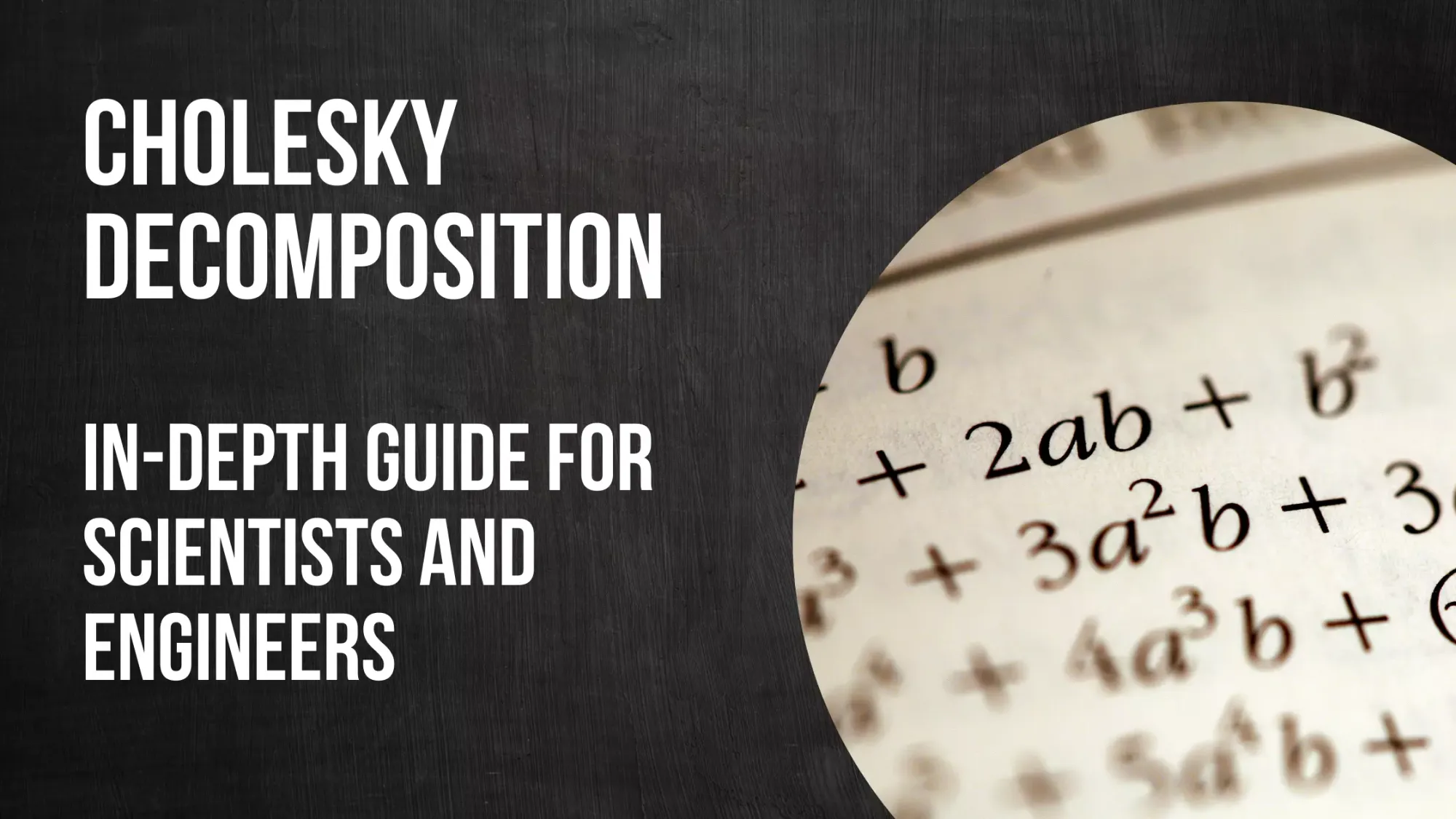Cholesky Decomposition: In-Depth Guide for Scientists and Engineers

Cholesky Decomposition, named after André-Louis Cholesky, a French military officer and mathematician, is a powerful tool in linear algebra that simplifies computational techniques, particularly in optimization, numerical solutions of differential equations, and simulation. This guide will delve into the details, breaking down its mathematical formulation, practical applications, and its importance for scientists and engineers.
Overview
The Cholesky Decomposition is a method of decomposing a Hermitian, positive-definite matrix into the product of a lower triangular matrix and its conjugate transpose. This is an efficient approach when dealing with systems of linear equations, particularly when the matrix involved is large and sparse.
Mathematically, if \(A\) is a symmetric, positive-definite matrix, then there exists a lower triangular matrix \(L\) such that:
\[ A = LL^T, \]
where \(L^T\) is the transpose of \(L\).
Mathematical Derivation
Let's break down the Cholesky decomposition in a step-by-step process using a 3x3 matrix as an example.
Given a symmetric, positive-definite matrix \(A\):
\[
A =
\begin{bmatrix}
a & b & c \\
b & d & e \\
c & e & f
\end{bmatrix}.
\]
We want to find a lower triangular matrix \(L\):
\[
L =
\begin{bmatrix}
l_{11} & 0 & 0 \\
l_{21} & l_{22} & 0 \\
l_{31} & l_{32} & l_{33}
\end{bmatrix}
\]
such that \( A = LL^T \).
The Cholesky algorithm fills in the entries of \(L\) one at a time. The entries of \(L\) are given by:
\[
l_{jj} = \sqrt{ a_{jj} - \sum_{k=1}^{j-1} l_{jk}^2 } \quad \text{for } j=1, \ldots, n,
\]
\[
l_{ij} = \frac{1}{l_{jj}} \left( a_{ij} - \sum_{k=1}^{j-1} l_{ik} l_{jk} \right) \quad \text{for } i=j+1, \ldots, n.
\]
By applying these equations, we can perform the decomposition on any symmetric positive-definite matrix.
How to Calculate Cholesky Decomposition
The Cholesky Decomposition of a symmetric, positive-definite matrix \(A\) can be calculated in a step-by-step process. Here is a simple algorithmic breakdown for a 3x3 matrix, though the process can be extended to larger matrices.
Let's assume a symmetric, positive-definite matrix \(A\):
\[
A =
\begin{bmatrix}
a_{11} & a_{12} & a_{13} \\
a_{12} & a_{22} & a_{23} \\
a_{13} & a_{23} & a_{33}
\end{bmatrix}
\]
We aim to find a lower triangular matrix \(L\) such that \( A = LL^T \).
\[
L =
\begin{bmatrix}
l_{11} & 0 & 0 \\
l_{21} & l_{22} & 0 \\
l_{31} & l_{32} & l_{33}
\end{bmatrix}
\]
The elements of the lower triangular matrix \(L\) are computed as follows:
Calculate the elements on the diagonal:
\[
l_{jj} = \sqrt{ a_{jj} - \sum_{k=1}^{j-1} l_{jk}^2 } \quad \text{for } j=1, \ldots, n
\]
Calculate the off-diagonal elements:
\[
l_{ij} = \frac{1}{l_{jj}} \left( a_{ij} - \sum_{k=1}^{j-1} l_{ik} l_{jk} \right) \quad \text{for } i=j+1, \ldots, n
\]
By applying these equations, we can perform the Cholesky Decomposition on any symmetric positive-definite matrix.
Here is the Cholesky Decomposition algorithm in a nutshell:
- Initialize an empty \(n \times n\) matrix \(L\).
- For each row from 1 to \(n\):
- Calculate the diagonal element using the first formula.
- Calculate the off-diagonal elements in the row using the second formula.
This algorithm assumes that the input matrix is symmetric and positive-definite. It does not check for these properties, and may produce incorrect results or fail to complete if these conditions are not met.
The intuition behind Cholesky Decomposition can be best understood in the context of multivariate statistics and linear algebra. Here are a few ways to think about it:
Square Root of a Matrix: Cholesky Decomposition is often thought of as taking the "square root" of a matrix. Just as the square root of a number \(x\) is a number \(y\) such that \(y^2 = x\), the Cholesky Decomposition of a matrix \(A\) is a matrix \(L\) such that \(LL^T = A\). This is a powerful concept, especially when dealing with covariance matrices in statistics, where Cholesky Decomposition helps in understanding the underlying correlations.
Transformation of Independent Variables: In multivariate statistics, if you have a set of independent random variables and you want to transform them into a new set of variables that have a specified covariance structure, you can use the Cholesky Decomposition. The lower triangular matrix (L) obtained from the decomposition of the covariance matrix can be used to transform the independent variables into correlated variables.
Solving Linear Systems: When solving systems of linear equations (\(Ax = b\)), it's often easier to deal with a lower triangular matrix, where forward and back substitution can be used. Cholesky Decomposition transforms \(A\) into \(L\) and \(L^T\), which simplifies the process. The system \(Ax = b\) becomes \(LL^Tx = b\). Then, we first solve \(Ly = b\) for \(y\) using forward substitution, and then solve \(L^Tx = y\) for \(x\) using back substitution.
Positive Definite Matrices: For a matrix to have a Cholesky Decomposition, it must be symmetric and positive definite. Positive definiteness is a key property in many areas of mathematics and engineering. This property ensures that all the eigenvalues of the matrix are positive, which often translates into stability in systems modeled by these matrices.
Remember, though, while these intuitions provide some insight, the Cholesky Decomposition is a mathematical procedure that can be applied wherever its conditions are met, whether or not we have an intuitive understanding of what's going on.
Algorithms for efficient computation
The most common algorithm used for computing the Cholesky decomposition is the Cholesky–Banachiewicz algorithm. This algorithm calculates the elements of the Cholesky factor from the top left of the matrix to the bottom right. It is a direct method and requires square root operations.
Here is a simple outline of the Cholesky–Banachiewicz algorithm:
- For each row \(i\) (from 1 to \(n\)), do the following:
- Calculate the diagonal element as \(l_{ii} = \sqrt{ a_{ii} - \sum_{k=1}^{i-1} l_{ik}^2 }\).
- For each element below the diagonal in the same column \(j\) (from \(i+1\) to \(n\)), calculate \(l_{ji} = \frac{1}{l_{ii}} \left( a_{ji} - \sum_{k=1}^{i-1} l_{jk} l_{ik} \right)\).
There is another method known as the Cholesky–Crout algorithm. It is very similar to the Cholesky–Banachiewicz algorithm, but it calculates the elements of the Cholesky factor from the top left of the matrix to the bottom right.
Both algorithms are computationally efficient, with a time complexity of \(O(n^3/3)\), where \(n\) is the number of rows (or columns) in the input matrix. This makes them significantly more efficient than general methods for solving systems of linear equations or calculating matrix inverses, which have a time complexity of \(O(n^3)\).
It's important to note that these algorithms are only efficient if the matrix is sparse and the sparsity is properly exploited. For dense matrices, the time complexity is effectively \(O(n^3)\).
Lastly, these algorithms are usually implemented in a blocked format that exploits the cache memory of modern computers to further speed up the computation. In this format, the matrix is divided into smaller blocks, and the computation is done block by block. This reduces the number of memory access operations and increases computational speed.
Algorithm implementations in popular programming languages
Sure, here's how you can calculate the Cholesky Decomposition in various programming languages:
MATLAB & Octave
In MATLAB and Octave, you can use the built-in chol function to compute the Cholesky Decomposition:
% Define a symmetric, positive-definite matrix
A = [4 12 -16; 12 37 -43; -16 -43 98];
% Compute the Cholesky Decomposition
L = chol(A, 'lower');
Here, 'lower' specifies that we want a lower triangular matrix. If you want the upper triangular matrix, you can replace 'lower' with 'upper'.
Python
In Python, the NumPy and SciPy libraries have built-in functions to compute the Cholesky Decomposition:
import numpy as np
# Define a symmetric, positive-definite matrix
A = np.array([[4, 12, -16], [12, 37, -43], [-16, -43, 98]])
# Compute the Cholesky Decomposition
L = np.linalg.cholesky(A)
For further details on how to calculate the Cholesky decomposition using Python check our previous post:

C++
In C++, you can use the Eigen library, which provides a function for the Cholesky Decomposition:
#include <Eigen/Dense>
// Define a symmetric, positive-definite matrix
Eigen::Matrix3f A;
A << 4, 12, -16, 12, 37, -43, -16, -43, 98;
// Compute the Cholesky Decomposition
Eigen::LLT<Eigen::Matrix3f> lltOfA = A.llt();
Eigen::Matrix3f L = lltOfA.matrixL();
In this code, Eigen::LLT computes the Cholesky Decomposition of the matrix, and matrixL() returns the lower triangular matrix.
Julia
In Julia, the built-in cholesky function can be used to compute the Cholesky Decomposition:
# Define a symmetric, positive-definite matrix
A = [4 12 -16; 12 37 -43; -16 -43 98]
# Compute the Cholesky Decomposition
L = cholesky(A).L
In all these examples, please ensure that the input matrix is symmetric and positive-definite. If the matrix is not symmetric and positive-definite, these functions may produce incorrect results or fail to execute.
Applications
Cholesky Decomposition's utility spans a broad spectrum of fields and applications due to its computational efficiency and numerical stability. It helps in tackling large-scale problems and provides efficient solutions to various mathematical and real-world problems.
However, it's crucial to note that Cholesky Decomposition is not a one-size-fits-all solution. Its effectiveness depends on the symmetry and positive definiteness of the matrices involved, and therefore it may not be suitable for all scenarios. It's an excellent tool to have in your mathematical toolbox, but it's equally important to understand when and how to use it effectively.
Numerical Simulations and Optimizations
In the realm of numerical simulations and optimizations, Cholesky Decomposition comes in handy for solving large systems of linear equations. This is particularly true when dealing with the computation of the inverse of matrices.
For example, consider the finite element method (FEM) in structural engineering simulations. The FEM transforms the complex equations of solid mechanics into a system of linear equations. This system is usually symmetric and positive-definite, making it a good candidate for Cholesky Decomposition.
Machine Learning and Data Science
In machine learning and data science, Cholesky Decomposition plays an integral role in several areas:
- Gaussian Processes: In Gaussian Process regression, a type of Bayesian regression, we use the Cholesky Decomposition to compute the inverse of the kernel (Gram) matrix, which is symmetric and positive-definite.
- Linear Regression and Principal Component Analysis (PCA): These techniques often involve operations on the covariance matrix, which is symmetric and positive-definite. Cholesky Decomposition is used to improve the numerical stability of these operations.
- Least-Squares Optimization: Many machine learning algorithms, such as neural networks and support vector machines, involve least-squares optimization during the training phase. Cholesky Decomposition can be used to efficiently solve the normal equations, which are the result of setting the gradient of the sum of squared errors to zero.
Signal Processing
In signal processing, Cholesky Decomposition is used in linear predictive coding (LPC). LPC is a tool used in audio signal processing and speech synthesis for representing the spectral envelope of a digital signal of speech in compressed form. It uses the method of linear prediction to predict future values of the signal based on a linear function of previous samples.
Finance
In the field of finance, particularly quantitative finance, Cholesky Decomposition plays a crucial role in Monte Carlo simulations. For example, when pricing complex financial derivatives, the underlying assets often follow a Geometric Brownian Motion with a specified correlation structure. To simulate these correlated asset paths, one can use Cholesky Decomposition on the correlation matrix to generate correlated random draws.
By simulating thousands or even millions of potential paths, the Monte Carlo method provides a powerful and flexible framework for pricing and risk management of complex financial products.
The power of Cholesky Decomposition is truly widespread across a variety of fields. Its ability to simplify and optimize calculations makes it an invaluable tool for scientists and engineers.
Computer Graphics and Physics Simulations
In computer graphics, Cholesky decomposition is employed to solve linear systems for realistic rendering of images. It's used in global illumination algorithms like radiosity, where we need to solve a large system of linear equations to calculate the light distribution in a scene.
Moreover, in physics-based simulations, for example, in cloth, fluid, or rigid body dynamics, the equations of motion often lead to a system of linear equations that can be solved using the Cholesky decomposition.
Control Systems
In control systems, Cholesky decomposition is often used in state estimation algorithms such as the Kalman filter. The covariance matrix in these algorithms, which quantifies the estimated state's uncertainty, is symmetric and positive definite, and operations on it can benefit from Cholesky decomposition.
Statistics
In statistics, Cholesky decomposition plays a vital role in multivariate normal distributions. For example, to generate random vectors with a specified covariance matrix, one can decompose the covariance matrix using the Cholesky decomposition and then apply it to independent standard normal random variables to induce the desired correlation.
Cholesky decomposition also finds applications in the design of experiments (DOE), where it helps in generating designs with specified correlation structures, and in estimating the parameters of linear models in a numerically stable manner.
Geophysics
In geophysics, Cholesky decomposition is used in seismic data processing and interpretation. It is used in inversion algorithms that convert observed measurements into a model of the subsurface. These algorithms often involve solving large systems of equations that can be addressed effectively using Cholesky decomposition.
Why Cholesky Decomposition is Important
The Cholesky Decomposition is highly efficient compared to other methods, such as LU Decomposition or Gaussian Elimination, for solving systems of linear equations. This is because the symmetry and definiteness of the matrix \(A\) are exploited to perform fewer computations.
The Cholesky Decomposition is also numerically stable. Because it only deals with real numbers and square roots, rounding errors in calculations are minimized, making it a preferable choice in most numerical computations.
Additionally, it enables easier computations for the determinant of a matrix. The determinant of the original matrix \(A\) is simply the square of the product of the diagonal elements of \(L\), which is computationally efficient.
Limitations and Precautions
Cholesky Decomposition's utility spans a broad spectrum of fields and applications due to its computational efficiency and numerical stability. It helps in tackling large-scale problems and provides efficient solutions to various mathematical and real-world problems.
However, it's crucial to note that Cholesky Decomposition is not a one-size-fits-all solution. Its effectiveness depends on the symmetry and positive-definiteness of the matrices involved, and therefore it may not be suitable for all scenarios. It's an excellent tool to have in your mathematical toolbox, but it's equally important to understand when and how to use it effectively.
Conclusion
Cholesky Decomposition is a powerful tool for scientists and engineers due to its computational efficiency, simplicity, and numerical stability. Its uses in fields such as numerical simulations, machine learning, signal processing, and finance highlight its importance. However, understanding its applicability and being aware of its limitations is crucial for its successful application. As with any tool, its power is best harnessed when its strengths are utilized appropriately and its limitations are well understood.
